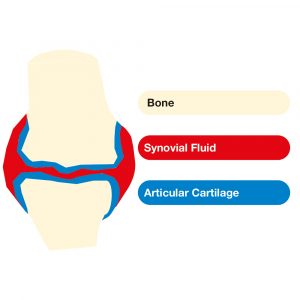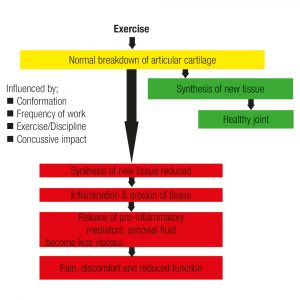Joint health & function in horses
Performance horses undergo a wide range of movements and actions placing their muscular and skeletal systems under constant pressure. Consequently, injuries and disease to joints are a common problem which can often result in a premature end to the career of the athletic horse. In addition to ramifications to performance, pain and immobility can have detrimental consequences to quality of life and longevity. Simply, a joint is defined as the union between two or more bones which in conjunction with muscles and tendons allow the skeleton to move. Many different types of joints are present in the horse’s body, the most commonly affected joint being the synovial joint (located in the fetlock, knee and stifle) as shown below.
Synovial joints are predisposed to injury as they are the most active joints in the horse’s body. They consist of two bone ends covered by articular cartilage which is so smooth and resilient that, when properly lubricated, enables frictionless movement of the joint. Synovial fluid is contained in the joint capsule and
provides lubrication for the joint. A key component of synovial fluid is sodium hyaluronate, providing a medium to transfer nutrients within the joint while also providing the viscous fluid to enable smooth movement and transfer of pressure within the joint.
For a synovial joint to function in a normal, pain free and efficient manner, maintaining the structure and function of the articular cartilage covering the ends of the bones is paramount. In normal, healthy joints the articular cartilage is regenerated to maintain healthy joint function, during which the outer lining is degraded and replaced with a new healthy lining. However due to poor blood supply and constant movement of synovial joints, the smooth cartilage lining begins to degrade at a rate which cannot be replaced by healthy new cartilage. Consequently, a cascade of detrimental events occur within the joint which commonly leads to osteoarthritis, compromising future joint health and function.
Osteoarthritis is characterised by the erosion of articular cartilage and is a major cause of lameness in exercising horses. Degeneration of the articular cartilage can result in irreversible osteoarthritis.


Studies investigating the treatment of osteoarthritis have shown benefit in providing the following components of Flexi-Joint Plus;
- Glucosamine Sulphate; assists cartilage formation/repair and reduces the formation of inflammatory mediators thereby reducing joint pain associated with osteoarthritis.
- Chondroitin Sulphate; inhibits the enzymes associated with cartilage degeneration.
- Manganese Chelate; necessary for the production of synovial fluid (joint lubricant).
- Bioavailable Curcumin- A powerful natural anti-inflammatory.
- MSM- A natural anti-inflammatory.
- Vitamin C- Which is essential for the health of cartilage and connective tissues
Osteoarthritis is a condition that cannot be cured and the goals in treating the disease are to alleviate discomfort, prevent further degeneration of cartilage and restore the affected joints to as near normal function as possible. It would be recommended to contact your veterinarian for an effective management or treatment program containing an oral glucosamine and chondroitin supplement such as Flexi-Joint Plus.
Preventative measures such as feeding glucosamine and chondroitin from an early age prior to any signs of compromised joint integrity would be recommended. Aiming to reduce irreversible articular cartilage degradation process which commonly leads to osteoarthritis.

Experts in Equine Nutrition
Every product in the Ranvet range has been developed to meet a horse’s most specific need at any given time, be it in a training environment or on a breeding farm. Having pioneered the formulation of specific medications and dietary supplements for horses, the company is now recognised as a leader in the areas of equine health and nutrition.
